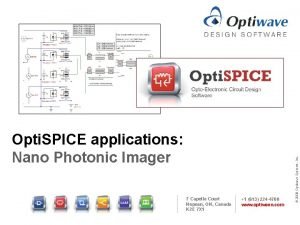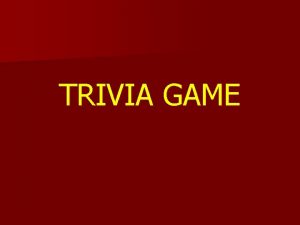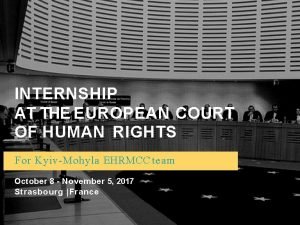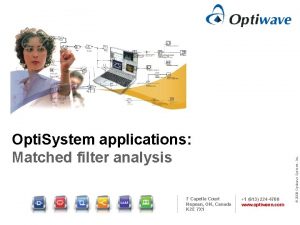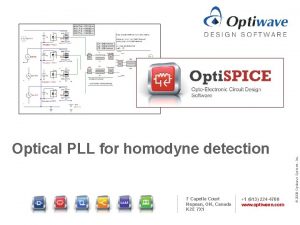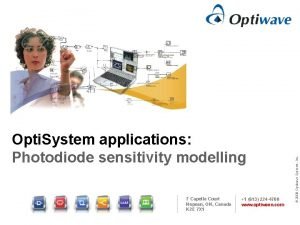7 Capella Court Nepean ON Canada K 2




- Slides: 4

7 Capella Court Nepean, ON, Canada K 2 E 7 X 1 +1 (613) 224 -4700 www. optiwave. com © 2009 Optiwave Systems, Inc. Opti. SPICE applications: Nano Photonic Imager

Nanophotonic Imager Schematic* 4 x 4 = 16 Pixels Basic Operation • This example demonstrates the operation of a nanophotonic coherent imager (4 x 4 pixels) • The chirped signal coming from the laser is split into reference (16) image (16) signals. • Each image signal travels through a different path and gets recombined at the pixel with a reference signal. • Due to the path difference, combined signals produce a different beating frequency at the output of the photodiode. • With this technique high resolution depth profiles can be measured Laser chirped by the voltage source 1 to 32 Splitter Simulation Parameters c = 299792458 Speed of Light (m/s) PER=500 e-6 Chirp Period (s) tf = 1. 02*PER Total Simulation time(s) tstep = tf/20000 Time step (s) fmax = 40 e 9 Maximum Frequency (Hz) alpha = fmax/PER Chirp Rate (Hz/s) lam 0 = 1550 Initial Wavelength (nm) lam 1 = c/(c/(lam 0)+fmax*1 e-9) Final Wavelength (nm) Different Path Delays The output of the photodiode is processed using a python script to estimate the time delay difference between two inputs *Firooz Aflatouni, Behrooz Abiri, Angad Rekhi, and Ali Hajimiri, "Nanophotonic coherent imager, " Opt. Express 23, 5117 -5125 (2015) 2

Principle of Operation • • • Laser output is linearly chirped by the voltage source and then split into twice the number of pixels Chirped signal goes through 2 different paths with different delays, reference path and object path. These signals are combined before they reach a photodiode Each photodiode output oscillates at a different frequency (f) proportional to the delay between two paths (tau) and the chirp rate (alpha), Linearly Chirped Laser Output f = alpha*tau • • • The frequency of the photodiode output can be calculated as the inverse of the average time between zero crossings multiplied by 0. 5 The delay calculated from each pixel can be used to recreate the depth image of the object The minimum resolution depends on various factors such as the maximum frequency, distance from the imager to the object and time step/sampling rate Pixel Subcircuit Photodiode Output

Simulation Results Measured Image Input Image % Error Input vs Measured Delay Pixel 1 2 3 4 1 0. 002100 0. 000498 0. 002100 2 0. 000498 0. 001268 0. 000498 3 0. 000498 0. 001268 0. 000498 4 0. 002100 0. 000498 0. 002100 % Error Input vs. Measured Delay Relative to Pixel 22 Results relative to pixel 22 Object is at 0. 5 m distance Pixel 1 2 3 4 1 3. 12459 9. 36726 3. 12459 2 9. 36726 0. 00000 9. 36726 3 9. 36726 0. 00000 9. 36726 4 3. 12459 9. 36726 3. 12459
